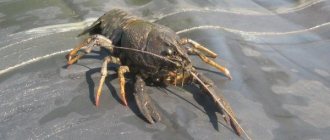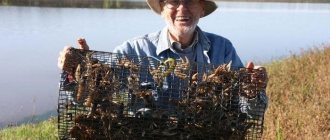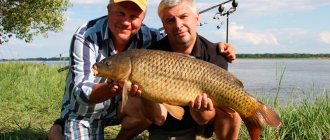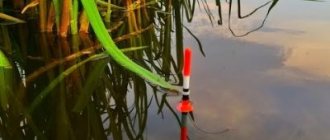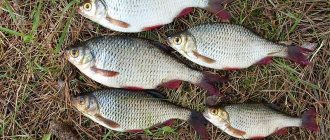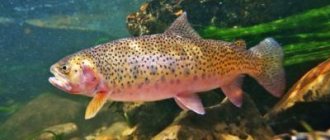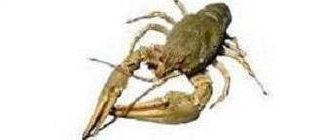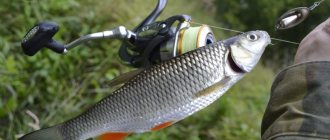Boiled crayfish are a tasty delicacy. This is why many people are interested in what places to catch crayfish. Let's try to figure out where catching crayfish will be successful. First, look for a body of water that is known to contain crayfish - it can be either a lake or a river. The next task is to decide on the choice of place for catching the crayfish themselves in a given reservoir. In theory, crayfish can be found almost anywhere in a body of water, but keep in mind that crayfish are shy and cautious - they rarely look into crowded places. Let's study places where catching crayfish will give a guaranteed result. Important: During the period when you can catch crayfish, use no more than three crayfish traps per citizen, with a diameter of each crayfish trap of more than 80 cm and a cell pitch of less than 22 mm. It is also prohibited to catch crayfish by hand by wading or by diving - you will be fined for illegally catching crayfish. And where it is allowed to catch crayfish in other ways, you can try your luck.
How to catch crayfish at night in autumn
One of the favorite ways of catching crayfish among fishermen is to hunt them on an autumn night with a flashlight and a net. At this time of year, quite significant temperature changes occur, when frosts often occur at night, and daytime heat is enough for the upper water layers to warm up a little. Therefore, at night, crayfish crawl to the shore of the reservoir, where the water is much warmer, to warm up or feed. As a rule, this season for night catching crayfish lasts from the first days of September until the start of freeze-up. Although such hunting is not available on every body of water, and not every one of them is suitable for this. Usually, crayfish are waited near fairly deep places so that they crawl out to the very edge of the shore, where they are often taken directly with their hands. At this time, at night the air cools to such an extent that wet hands literally freeze on it, but the water is warm enough to warm them up. That is why crayfish crawl to the shore, into warm water layers. It is better to hunt crayfish on an autumn night with two or three of them, moving along the shore in a chain. One must go with a flashlight and, shining a beam through the water column, find crayfish, which betray their presence with glowing red eyes. The second should follow and pull out the prey with a net, and the third should carry it in a bag. A net for night hunting for crayfish must be made of a strong pole so that it can withstand and not break when scooping the prey ashore. In order for the fishing to be successful, the crayfish should be covered with a net from above, drowned a little in the silt, and scooped ashore with it, so the prey has practically no chance of escaping. The handle of the net should be approximately 2-2.5 meters, no more, since crayfish are usually located a meter or two from the shore. It is better not to reach for those individuals that will be located further than this distance, since due to the large thickness of water it will not be possible to quickly cover the crayfish, and it, sensing danger in the form of an approaching net, will simply leave.
Catching crayfish in the reeds in autumn
Almost every body of water has places where reeds grow. This place is good for catching crayfish because people usually don’t swim there and don’t scare the crayfish. In such places, catching crayfish is good, although it is difficult with the reeds themselves.
The tactics for catching crayfish in the reeds in the fall are simple. Slowly swim along the reeds and look carefully at the bottom, as it can be difficult to notice crayfish there due to the fact that they are well camouflaged in the reeds.
Precautions when catching crayfish in reeds. Swim carefully in or near reeds to avoid cutting yourself or becoming entangled.
Catching crayfish in autumn in quiet creeks with snags and tree roots
Catching crayfish here is a pleasure, but you need to take into account that if you don’t know what the bottom is, then it’s better not to go there at all, especially if the water is cloudy.
Tactics for catching crayfish in autumn in creeks with snags. Don't make any sudden movements, but catch the crayfish with confidence. From my own experience, I know that such places are usually inhabited by large old crayfish, whose shell is dark brown. Such crayfish are slow and for an experienced fisherman it is not difficult to catch them. There are exceptions in the form of young crayfish in such places, but this is rare.
Precautions when catching crayfish in creeks with snags. If you still decide to catch crayfish in snags, then carefully examine the bottom, without sudden movements, etc.
Catching crayfish on a rocky bottom in autumn
Where there is a rocky bottom, there are a lot of natural holes for crayfish, which like to hide in them in case of danger.
Tactics for catching crayfish in the fall on a rocky bottom. Do not grab crayfish by the protruding claws from their burrows, since there is a high chance that your trophy will only be the claw itself; rather, grab them by the whiskers - the crayfish always sticks them out, even after an unsuccessful attempt to get it. Raise the stone above the hole, but be careful not to stir up the water and thus lose sight of the crayfish, who, in turn, will have time to escape to another place.
Precautions when catching crayfish on a rocky bottom in the fall. You should not put your hands in the holes - this action can injure your hand on the crayfish. There were cases when large stones crushed the hands of catchers, and the matter ended with bruises and broken fingers.
Catching crayfish in autumn in a shell rock
The bottom in such places is completely strewn with remnants of reeds and entire colonies of river mollusks. Cancers are frequent guests in such places.
Tactics for catching crayfish in the fall in a shell shell. We swim slowly and carefully examine the bottom, since crayfish can simply camouflage themselves in colonies of mollusks and remnants of reeds.
Precautions when catching crayfish in the fall in shell beds. Be careful when catching crayfish in such places - you can easily cut yourself on the shells of the mollusks. Standing with unprotected feet in such places is also not recommended.
Catching crayfish on a sandy bottom in autumn
Perhaps the most ideal place for all crayfish fishermen, both beginners and experienced. The bottom is clean, the sand is fine and the water practically does not muddy. In such places you can often find the dark green hornwort plant, but not in large quantities.
Tactics for catching crayfish on a sandy bottom. We swim and look from side to side, since visibility is good and crayfish can be seen perfectly at a decent distance.
Precautions when catching crayfish on a sandy bottom in the fall. No matter how safe the place is, always be careful; even on such sandstones, catchers managed to get injured. Sandstone, although safe, is still...
Catching crayfish in burrows in autumn
A separate topic for conversation. Or, if I may say so, a complete precaution. If you come across a place where a depth of 2-3 meters sharply begins immediately from the shore, then when you dive, you may find a hole in front of you, or even more than one. Remember, crayfish are rare in such holes, and the holes belong to muskrats. NEVER put your fingers in there unless you want to get seriously injured.
If crayfish make holes for themselves, they are small ones - depending on the size of the crayfish, the hole can be 4-5 cm in height and 7-8 cm in width.
Catching crayfish in autumn in bottles and cans
Favorite places for crayfish are broken bottles with the bottom or neck intact and tin cans (for example, from stewed meat). You can find such goodness in almost any body of water. Most cans and bottles, as a rule, are not empty - they contain crayfish. Tactics for catching crayfish. If you see a can (bottle), you lift it with the open part towards you. Cancer will not have time to escape, since he runs away “backward”, and behind his “back” is a dead end. You shake the crayfish out of its shelter either directly underwater, or surface and pull out the crayfish. If the jar (bottle) is empty, then throw it deeper into the water, leave it in place, just put it so that no one is injured, or pull this container ashore.
Precautions when catching crayfish. Be careful not to cut yourself on the sharp edges of the jar (bottle).
Most often, to catch crayfish in the fall, they set up the usual crayfish traps - metal cages and bait (usually live fish). The cancer crawls into the trap along the inclined wall and begins to eat easy prey, but cannot quickly get out. You just need to check the crayfish trap regularly. Crayfish are also caught using a fishing rod. You can make this simple tool yourself. Attach a bait to a stick pointed at one end and equip the rod with fishing line. It is best to use a frog or small fish as bait. Such bait must be wrapped in a net or nylon stocking. Having noticed the bait, the cancer will try to grab it as tightly as possible, and when this happens, you can safely pull out the prey. Cancer is a very clean creature, and the assumption that it feeds on dead fish or drowned animals is completely wrong. Cancer will never eat rotten meat or fish. Its food is exclusively grass, algae, larvae, mollusks and small fish. The best time to catch crayfish is from 10 pm to 3 am. But sometimes crayfish hunt in the pre-dawn hours, and this is also worth taking into account. Some crayfish hunters note that prey can always be lured. To do this, you need to light a fire on the shore, and if you are fishing from a boat, then take a lantern with you. Arthropods really love such illumination and actually run to the bait.
Tips for catching crayfish with a flashlight
The choice of location directly affects the volume of catch. Unlike daytime fishing, it is recommended to stop on a gently sloping bank where the depth level is minimal. There the water temperature will be as high as possible in the entire reservoir. The best option is that a sharp change in the bottom topography begins 10-15 meters from the shore.
Rules for choosing an inexpensive and reliable motor for a PVC boat
To effectively catch crayfish you will need the following:
- Flashlight. It is advisable that it have a water-resistant case, as there is a high probability of dropping it into water. You will also need a securing cord to secure it to your hand in case the flashlight falls.
- Net or gloves. They are necessary to protect hands from possible damage from claws. The first requires practice, since when there is danger, the crayfish can develop high speed - in one swing of the tail it moves 20 cm.
- Boots or other waterproof footwear. Water temperatures may be low during the fishing season. To prevent chills or illness, foot protection is recommended.
Cloudy weather increases the chances of large numbers of prey. But it can also cause poor visibility. Read about how atmospheric pressure affects fishing here.
How to cook crayfish correctly
Crayfish should be immediately placed in cold water for 1-2 hours. Sometimes they are put in milk to make the meat more tender. It is advisable to wash the belly of the crayfish before cooking. But since crayfish are active and their claws are strong, it is better not to take risks. After soaking the crayfish, rinse them very thoroughly with running water. To boil crayfish, you need to take a large pan - the crayfish should not be tightly packed in it. Bring water to a boil, add salt. It is best to take rock salt and a lot of it - half a tablespoon per liter of water. Add dill, pepper and something sour - lemon or apple. Throw live crayfish into boiling water. If the crayfish has died, it should never be eaten, so I welcome it when crayfish are sold alive in a store aquarium. Cook for no more than 10 minutes. They take longer to digest and the meat becomes tough. Then turn off the water and leave the crayfish to soak in the brine. Sometimes crayfish are soaked in wine, baked in the oven, stuffed with cheese and vegetables, but I prefer the classics - after all, the eating process itself, which you usually share with friends, is important.
Is it possible to get poisoned by crayfish?
Toxic substances in crayfish accumulate in the gill part - in the so-called “fur” pockets. Many people like to savor their juice. This is not worth doing. If the crayfish dies, the decomposition process begins very actively, so you should never buy boiled crayfish. If they start convincing you that living crayfish simply “fell asleep,” do not fall for these tricks. Crayfish must be selected individually. You can often see so-called “caviar” crayfish being sold along the highway. I would report such would-be sellers to the competent authorities, so the entire population of arthropods can be wiped out.
How to breed crayfish at home
Breeding crayfish at home is almost impossible! The point is this: even breeds of crayfish that grow very quickly reach a size of 10 cm in two years. This means that after the cancer is born, it will take four years for them to reach the size you need, and all this time you will need to support them. Therefore, if you want to breed crayfish on your property, you need to dig a pond of such size that it does not freeze completely in winter. For crayfish on farms they install plastic pools 3 by 3 and a meter deep. The water is constantly circulated, filtered and aerated. That's why they are so clean. And they are so expensive because the equipment is not cheap and electricity is not free.
Where are crayfish found?
Under good reservoir conditions, you can catch crayfish anywhere. Whether it's a stream, an oxbow lake or a lake, a favorable environment will have a positive effect on your catch. However, the largest concentration of crayfish is in rivers. At this point they usually dig a place for themselves to hide.
Where can you catch crayfish ? Their frequent clusters:
- Muddy bottom
- Sandy shore
- Rocky coast
- Shallow water
- Clean bottom
- Slopes
- driftwood
Old people usually hide under a stone or tree. Young crayfish often come ashore.
Where do crayfish spend the winter?
Crayfish spend the winter in burrows. They bury themselves completely to a depth of 2-3 meters, leaving a small hole. It is difficult to detect them at the bottom, since they spend most of the day in hibernation and go out to get food for 2-3 hours. And the famous expression “I’ll show you where the crayfish spend the winter!” poses a threat only because in the old days serfs were sent to catch crayfish and they wandered in icy water in their underwear, looking for a delicacy. By the way, now is the time to catch crayfish: the water is clear and not cold yet, so good luck and bon appetit! Previously on the topic of catching crayfish:
- How to catch crayfish, when you can catch crayfish: Catching crayfish with a crayfish trap
| Where to catch crayfish | When can you catch crayfish? |
| What time do they catch crayfish? | Ban on catching crayfish |
| How to catch crayfish by hand | What bait to catch crayfish with |
| How to catch crayfish with an open crayfish trap | Do-it-yourself clamshell |
| How to catch crayfish with a closed crayfish trap | How to cook crayfish |
| How to catch crayfish with a fishing rod, spear, and shoe | Useful information about crayfish |
Fishing methods and techniques
There are many techniques for catching crayfish. The choice of any method depends directly on weather conditions, terrain, river depth and other things. Traps are often installed at a depth of one to three meters. But if algae or other vegetation is present, traps can be placed in recessed areas of five to ten meters. All methods can be divided into fishing:
- Hands;
- Rakolovka;
- Fishing rod and other equipment.
Fishing with a rod
Take an ordinary stick with a pointed end. On the one hand, a fishing line is attached to it, onto which the bait is attached. And on the other there is a rope that holds the stick. For reliability, the bait is placed in a kind of protective case, which does not allow the crayfish to catch its prey. In the meantime, he is trying to bite off what he wants, you can easily catch him on a hook, taking the crayfish out of the water.
With the help of crayfish
The simplest and most popular way of catching crayfish. Let's figure out how to properly catch crayfish with this effective tackle.
Rakolovka
Rakolovka are wire hoops that are covered with mesh or a regular rag. Sometimes a bait with a weighting agent is placed in the center of the crayfish shell. The shells are usually made of thin steel.
The hoop is tied with three ropes. They are tied to a fishing line that lifts the crayfish to the surface. The fishing line is attached to the tip of the stick. The crayfish sinks where it is quiet and close to the shore, as crayfish burrows are often located there.
A small but very informative video on catching crayfish with crayfish traps. Let's look:
A standard design is used as a shell.
Hand catching
If you are planning to catch crayfish, then night is the best option. After all, for crayfish, light is a bait to which they crawl out. Having lit a fire, you can notice how the crayfish themselves will crawl towards you. All that remains is to have time to see and catch them. Having caught crayfish, you should immediately start cooking, as carrion is tasteless.
Provided that the hunt will be carried out during the day, you should be patient. It is worth looking for these creatures in burrows and under stones. Remember that cancer moves quickly and backwards. Therefore, when you pick up a stone, be prepared to quickly catch your target. If you catch crayfish by hand, you need two people. One will search, and the other will aim and catch the crayfish.
Next is a video with the process of catching crayfish with bare hands, equipped with a mask, snorkel and fins for diving under water. Fishing is carried out exclusively by holding your breath and inhaling regular air through a tube.
